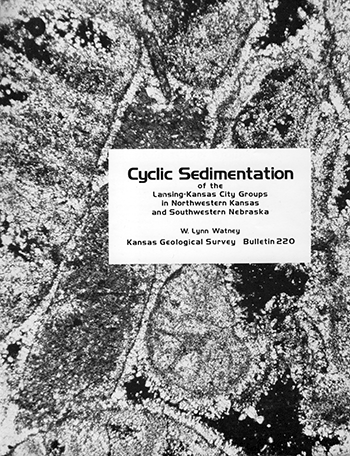Cyclic Sedimentation of the Lansing-Kansas City Groups in Northwestern Kansas and Southwestern Nebraska
A Guide for Petroleum Exploration
by W. Lynn Watney

Originally published in 1980 as Kansas Geological Survey Bulletin 220. This online version has been created because the published version is currently out of print. This is, in general, the original text as published. An Acrobat PDF version (12 MB) is also available; plate available separately.
Executive Summary
Accumulations of oil and gas that are small in size and difficult to find are being sought in Kansas because of the incentive of higher prices for newly discovered petroleum. Many of these smaller deposits are localized in subtle stratigraphic or combination structure-stratigraphic traps. Discovery of these traps requires the efficient use of all data, which also reduces the risk in drilling.
Carbonate reservoirs, such as those of the Upper Pennsylvanian Lansing-Kansas City Groups in western Kansas--the subject of this study--occur at intermediate depths (3000 to 4500 feet below the surface) and are generally small in size; furthermore, the void space (porosity) and ability to transmit fluids (permeability) of these carbonate rocks are highly variable.
This study integrates the examination of cores and cuttings with the analysis of geophysical logs in this sequence of reservoir rocks. This information is used to construct maps and cross sections that describe the depositional environments and post-depositional alteration of these rocks. Trends of increases in porosity and permeability, critical to a petroleum reservoir, can be identified by following this procedure. This analysis, with emphasis on the description and interpretation of the rock record, can be combined with mapping of subsurface structure from well-log and seismic data to lower the risk in exploring for petroleum reservoirs in these and similar rock units of western Kansas. Admittedly, the investment of time and money is greater than in a purely structural approach to prospect definition, but the resulting success ratio should also improve. As the data base grows, details of the reservoir characteristics will be better understood, which should lead to further increases in successful drilling.
Kansas Geological Survey, Cyclic Sedimentation
Comments to webadmin@kgs.ku.edu
Web version Oct. 2004. Original publication date Oct. 1980.
URL=http://www.kgs.ku.edu/Publications/Bulletins/220/index.html